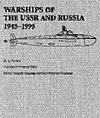 A.S. Pavlov, (Norman Friedman English Language edition), Naval Institute Press, 1997, 322 pp, ISBN 1-55750-671-X, $59.95
A.S. Pavlov, (Norman Friedman English Language edition), Naval Institute Press, 1997, 322 pp, ISBN 1-55750-671-X, $59.95
A.S. Pavlov has been a naval enthusiast for years in a country where collecting information on the military could get you shot. According to the fascinating introduction, he and his fellow naval buffs have exchanged handwritten notes, sharing what little they could find out.
Glasnost made things a little easier, and the breakup of the Soviet Union helped a lot, but the Russians still don't like anyone publishing too much about their military . Mr. Pavlov, a naval architect, has been in hot water with the authorities over his book, and we owe him a great deal for assembling and sharing what he knows with the rest of us. This book is the first modern naval Russian-language reference book to be translated into English. It has a "foreign" look to it, with a plain cover, and a simple, uncomplicated layout. It covers Pre-WW II designs that served postwar, postwar designs, and civilian ships used by the military. It's filled with nice photos and line drawings done by the author.
So is it accurate? The book is full of new, and mostly accurate information. Mr. Pavlov is a naval architect, and knows what he's talking about. On the other hand, official information about the Russian Navy is still hard to come by, and it's difficult to know how "hard" his sources are. On the other hand, the book's U.S. editor is Dr. Norman Friedman, one of the best naval writers in the business. His name on the book tells me Mr. Pavlov's done his homework.
There are rough spots, of course. While Mr. Pavlov provides NATO code names for the ship classes, he does not do so for the weapons or sensors. It's a little parochial to insist that a Russian book refer to Russian equipment by foreign names, but it would make life simpler to know that a Fut-N radar is the NATO Slim Net. Also, in many cases, he's listing new systems that have no NATO equivalent. It's hard to know which are which. For the next edition, I recommend tables of weapons and sensors listing systems and their NATO equivalents.
This is not a good "first book" about the Russian or Soviet navies. Norman Polmar's Guide to the Soviet Navy, 5th edition is still the most complete, if dated, "one-stop" source for the Russian Navy as a whole. A.D. Baker's Combat Fleets of the World is the most current and accurate for its ships. What Pavlov's book represents is their side of the picture, and it is immensely valuable because of that. It's the second book I'd check about a Russian ship.
BT
Back to The Naval Sitrep #12 Table of Contents
Back to Naval Sitrep List of Issues
Back to MagWeb Master Magazine List
© Copyright 1997 by Larry Bond and Clash of Arms.
This article appears in MagWeb (Magazine Web) on the Internet World Wide Web.
Other military history articles and gaming articles are available at http://www.magweb.com